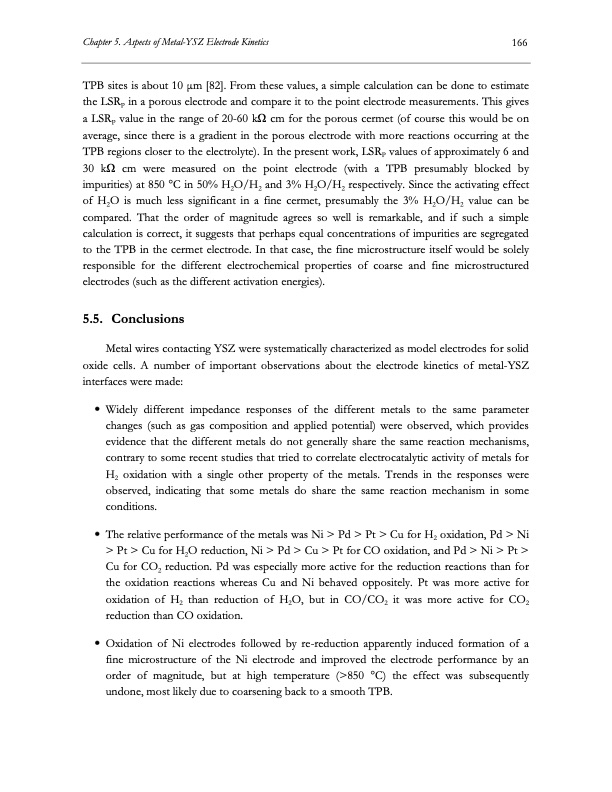
PDF Publication Title:
Text from PDF Page: 187
Chapter 5. Aspects of Metal-YSZ Electrode Kinetics 166 TPB sites is about 10 μm [82]. From these values, a simple calculation can be done to estimate the LSRP in a porous electrode and compare it to the point electrode measurements. This gives a LSRP value in the range of 20-60 kΩ cm for the porous cermet (of course this would be on average, since there is a gradient in the porous electrode with more reactions occurring at the TPB regions closer to the electrolyte). In the present work, LSRP values of approximately 6 and 30 kΩ cm were measured on the point electrode (with a TPB presumably blocked by impurities) at 850 °C in 50% H2O/H2 and 3% H2O/H2 respectively. Since the activating effect of H2O is much less significant in a fine cermet, presumably the 3% H2O/H2 value can be compared. That the order of magnitude agrees so well is remarkable, and if such a simple calculation is correct, it suggests that perhaps equal concentrations of impurities are segregated to the TPB in the cermet electrode. In that case, the fine microstructure itself would be solely responsible for the different electrochemical properties of coarse and fine microstructured electrodes (such as the different activation energies). 5.5. Conclusions Metal wires contacting YSZ were systematically characterized as model electrodes for solid oxide cells. A number of important observations about the electrode kinetics of metal-YSZ interfaces were made: Widely different impedance responses of the different metals to the same parameter changes (such as gas composition and applied potential) were observed, which provides evidence that the different metals do not generally share the same reaction mechanisms, contrary to some recent studies that tried to correlate electrocatalytic activity of metals for H2 oxidation with a single other property of the metals. Trends in the responses were observed, indicating that some metals do share the same reaction mechanism in some conditions. The relative performance of the metals was Ni > Pd > Pt > Cu for H2 oxidation, Pd > Ni > Pt > Cu for H2O reduction, Ni > Pd > Cu > Pt for CO oxidation, and Pd > Ni > Pt > Cu for CO2 reduction. Pd was especially more active for the reduction reactions than for the oxidation reactions whereas Cu and Ni behaved oppositely. Pt was more active for oxidation of H2 than reduction of H2O, but in CO/CO2 it was more active for CO2 reduction than CO oxidation. Oxidation of Ni electrodes followed by re-reduction apparently induced formation of a fine microstructure of the Ni electrode and improved the electrode performance by an order of magnitude, but at high temperature (>850 °C) the effect was subsequently undone, most likely due to coarsening back to a smooth TPB.PDF Image | Electrolysis of CO2 and H2O

PDF Search Title:
Electrolysis of CO2 and H2OOriginal File Name Searched:
co2-hso-fuels.pdfDIY PDF Search: Google It | Yahoo | Bing
NFT (Non Fungible Token): Buy our tech, design, development or system NFT and become part of our tech NFT network... More Info
IT XR Project Redstone NFT Available for Sale: NFT for high tech turbine design with one part 3D printed counter-rotating energy turbine. Be part of the future with this NFT. Can be bought and sold but only one design NFT exists. Royalties go to the developer (Infinity) to keep enhancing design and applications... More Info
Infinity Turbine IT XR Project Redstone Design: NFT for sale... NFT for high tech turbine design with one part 3D printed counter-rotating energy turbine. Includes all rights to this turbine design, including license for Fluid Handling Block I and II for the turbine assembly and housing. The NFT includes the blueprints (cad/cam), revenue streams, and all future development of the IT XR Project Redstone... More Info
Infinity Turbine ROT Radial Outflow Turbine 24 Design and Worldwide Rights: NFT for sale... NFT for the ROT 24 energy turbine. Be part of the future with this NFT. This design can be bought and sold but only one design NFT exists. You may manufacture the unit, or get the revenues from its sale from Infinity Turbine. Royalties go to the developer (Infinity) to keep enhancing design and applications... More Info
Infinity Supercritical CO2 10 Liter Extractor Design and Worldwide Rights: The Infinity Supercritical 10L CO2 extractor is for botanical oil extraction, which is rich in terpenes and can produce shelf ready full spectrum oil. With over 5 years of development, this industry leader mature extractor machine has been sold since 2015 and is part of many profitable businesses. The process can also be used for electrowinning, e-waste recycling, and lithium battery recycling, gold mining electronic wastes, precious metals. CO2 can also be used in a reverse fuel cell with nafion to make a gas-to-liquids fuel, such as methanol, ethanol and butanol or ethylene. Supercritical CO2 has also been used for treating nafion to make it more effective catalyst. This NFT is for the purchase of worldwide rights which includes the design. More Info
NFT (Non Fungible Token): Buy our tech, design, development or system NFT and become part of our tech NFT network... More Info
Infinity Turbine Products: Special for this month, any plans are $10,000 for complete Cad/Cam blueprints. License is for one build. Try before you buy a production license. May pay by Bitcoin or other Crypto. Products Page... More Info
| CONTACT TEL: 608-238-6001 Email: greg@infinityturbine.com | RSS | AMP |